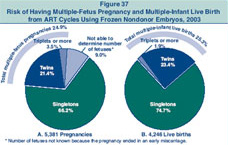What is the risk of having a multiple-fetus pregnancy or
multiple-infant birth from an ART cycle using frozen nondonor embryos?
Multiple-infant births are associated with greater
problems for both mothers and infants, including higher rates of caesarean
section, prematurity, low birth weight, and infant disability or death.
Part A of Figure 37 shows that
among the 5,381 pregnancies that resulted from ART cycles using frozen
nondonor embryos, slightly more than 66% were singleton pregnancies, about
21% were twins, and nearly 4% were triplets or more. Nine percent of
pregnancies ended in miscarriage before the number of fetuses could be
accurately determined. Therefore, the percentage of pregnancies with more
than one fetus might have been higher than what was reported (nearly 25%).
In 2003, 4,246 pregnancies from ART cycles that used frozen
nondonor embryos resulted in live births. Part B of
Figure 37
shows that approximately 25% of these live births produced more than one
infant (about 23% twins and 2% triplets or more). This compares with a
multiple-infant birth rate of slightly more than 3% in the general U.S.
population.
Although the total rates for multiples were similar for
pregnancies and live births, there were more triplet pregnancies than
triplet births. Triplet (or more) pregnancies may be reduced to twins or
singletons by the time of birth. This can happen naturally (e.g., fetal
death), or a woman and her doctor may decide to reduce the number of fetuses
using a procedure called multifetal pregnancy reduction. Information on
medical multifetal pregnancy reductions is incomplete and therefore is not
provided here.

Figure
37: Risk of Having Multiple-Fetus Pregnancy and Multiple-Infant Live
Birth from ART Cycles Using Frozen Nondonor Embryos, 2003.
|